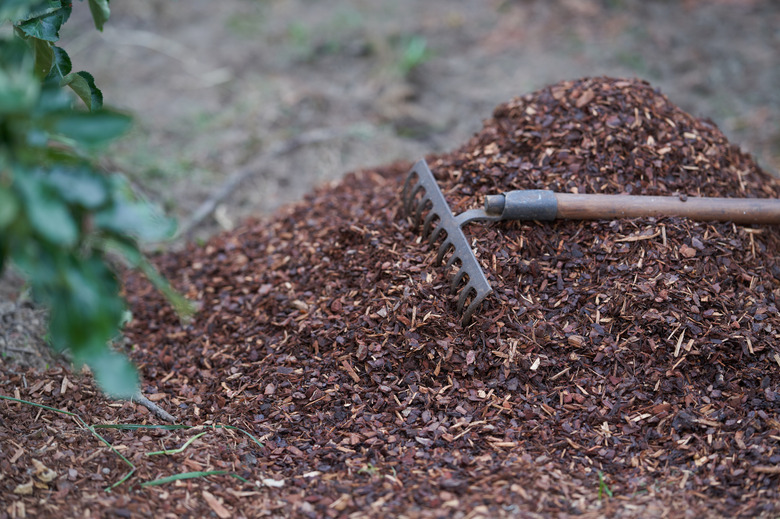How To Get Mulch To Stay On A Slope
We may receive a commission on purchases made from links.
Mulch is either a temporary solution to stabilizing bare soil until the landscaping become established or it protects soil between the plants. The mulch conserves soil moisture, evens soil temperatures, prevents or lessens wind and soil erosion and gives a substrate for plant establishment. Mulch moves downhill due to rainfall, wind and gravity; the steeper the slope, the harder it is to keep mulch in place. Choose the type of mulch and the stabilization method based on the soil type, the amount of rainfall and wind and the slope gradient.
Choosing a Mulch
Choosing a Mulch
Some mulch types stay in place better on steeper slopes. While wood chips work well on shallow slopes, avoid using on slopes steeper than 6 percent because they tend to wash away. For mulches desired to last for longer than three months on slopes steeper than 50 percent, it suggests straw or hay held in place by netting or other stabilizing agents. For extremely steep slopes, vegetative mulches may not work at all.
Pegs and Twine
Pegs and Twine
Used for hay or straw, pegs and twine anchor evenly applied layers of these mulches. Divide the mulched area into 1-square-yard grids and pound in four to six wooden pegs per block, leaving 2 to 3 inches of the stake sticking out of the ground. Wrap twine in a crisscross pattern over each block, going from peg to peg, with at least two turns of twine around the exposed part of the peg. This holds the surface of the hay or straw in place close to the soil.
Netting to Secure Mulch
Netting to Secure Mulch
Netting comes in many types. Natural jute netting and synthetic plastic netting hold down organic mulches such as straw, hay, wood chips, compost and manure. The netting extends out over the sides of the mulched area, with wire staples holding it in place around the edges. Other products combine the mulch with the netting.
Single or double layers of jute or synthetic netting hold together coconut fiber, excelsior, which is shredded aspen, straw or pine straw. The mulch and netting combinations come in many sizes, including rolls that can be cut into various widths. They are also called erosion control blankets. Bury the uphill edge of a blanket and overlap blankets to prevent water eroding soil beneath the blanket or wind from lifting it.
Crimping or Punching Mulch
Crimping or Punching Mulch
Also called cut-in mulch, this technique is used for hay or straw on small sites and on slopes steeper than 33 percent. Establish contour rows along the slope, and "punch" the straw into the soil every 18 inches along the row using a square-nosed spade. The straw should be standing perpendicular to the soil in the cut-in area, and the punched-in portion should go down about 4 inches into the soil, creating a tufted appearance.
In larger areas, heavy equipment may be needed to crimp or punch in the straw. In addition, rocky and heavy clay soils may be too difficult for hand tools; consider a different method of securing the mulch or use mechanical means to attach the straw mulch to the slope.
Terraces and Mulch
Terraces and Mulch
For extremely steep slopes, especially rocky areas that don't have much soil, vegetative mulches are difficult to hold in place. If conditions allow, consider breaking up the slope by establishing terraces or retaining walls.
For the front, soil-retaining edge of a terrace, use gravel, cement blocks, rocks, bricks, timbers or pieces of erosion control blankets made into fiber rolls, also called fiber logs. Hold rolls in place by partially burying them in the slope and driving stakes through them. The flat terraces behind the retaining walls will retain the mulch.
